
The application security market is estimated to be valued at USD 12.66 Billion in 2025 and is expected to reach USD 41.80 Billion by 2032, growing at a compound annual growth rate (CAGR) of 18.6% from 2025 to 2032.
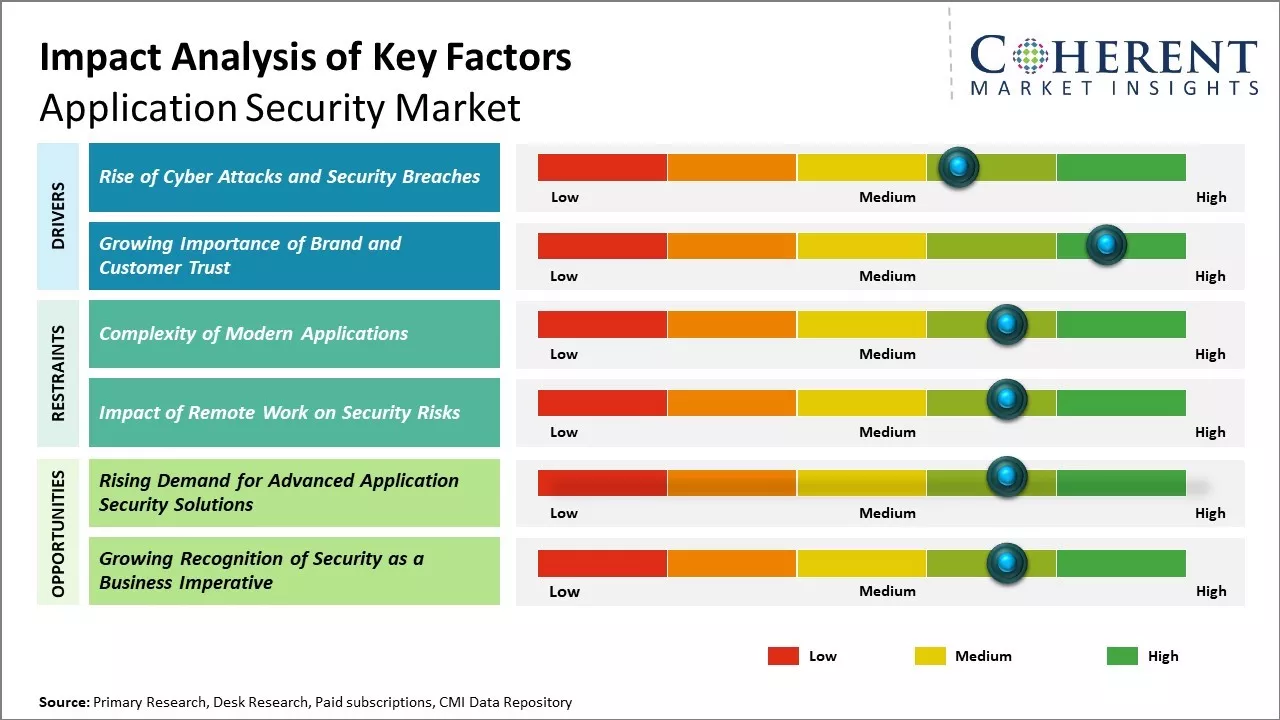
Discover market dynamics shaping the industry: Download Free Sample
The application security market trend has been rising significantly over the past few years. With growing cyber threats and increasing dependency of enterprises on applications, the demand for application security solutions has increased tremendously.
Key factors driving the market growth include rapid digitalization across industries, increasing revenue losses due to application breaches, rising adoption of cloud-based applications, and growing spend on application security by organizations to secure their brands. Rapid migration of applications to cloud-based platforms has also fuelled the need for effective security of applications. Furthermore, integration of AI and machine learning capabilities in application security solutions is expected to enhance their effectiveness and create new opportunities in the market going forward.
Rise of Cyber Attacks and Security Breaches
As digital transformation accelerates and more organizations move their operations and services online, the attack surface for cyber criminals has widened considerably. Sophisticated threat actors backed by nations are constantly probing networks for vulnerabilities while opportunistic hackers leverage readily available tools to compromise user credentials and launch ransomware attacks. High profile security breaches at major companies have heightened the awareness of cyber risks at the board level but have also given rise to more complex attacks aimed at critical infrastructure and supply chains. With more employees working remotely due to the pandemic, the enterprise perimeter has become even more diffused. Meanwhile, the proliferation of IoT devices have introduced new vectors for compromising networks.
For instance, in July 2023, the United States Departments of Justice (DOJ) and Homeland Security (DHS) launched StopRansomware.gov, a website dedicated to providing ransomware information and mitigation strategies for individuals, corporations, and organizations. This is the first joint website by the federal government to assist public and private entities in managing ransomware risk.
Growing Importance of Brand and Customer Trust
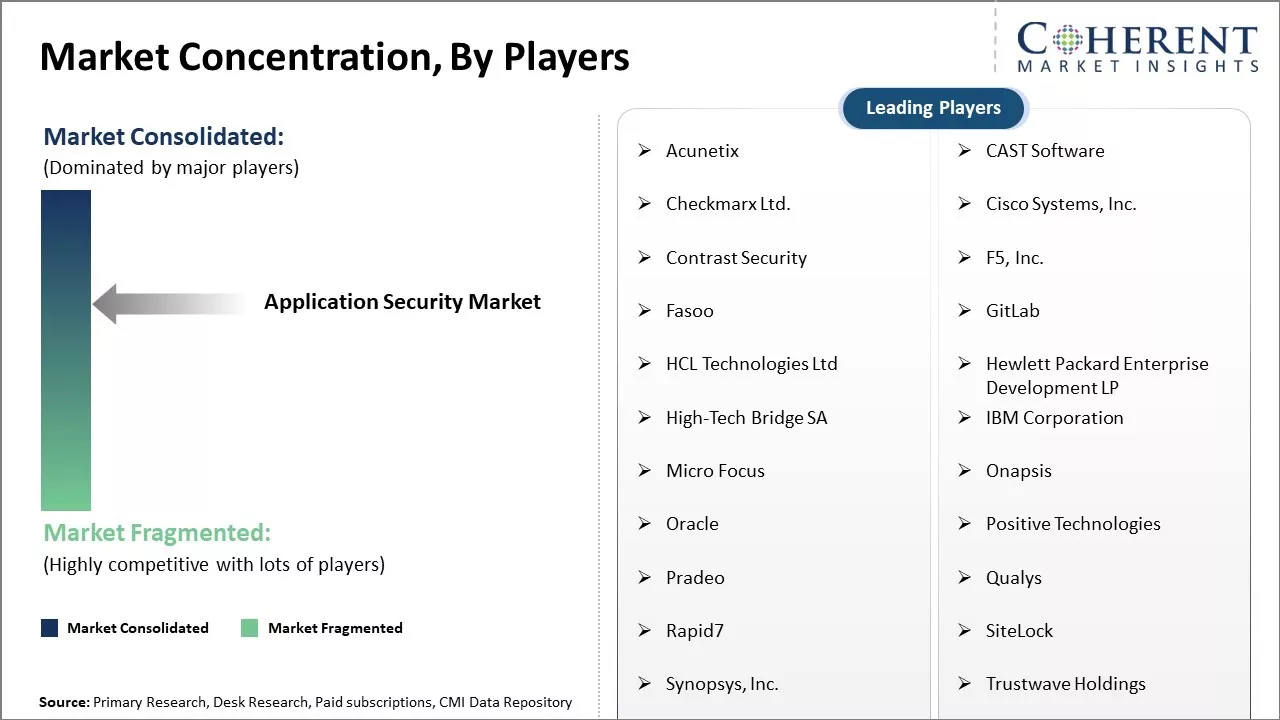
Get actionable strategies to beat competition: Download Free Sample
As digital interactions become the primary way customers engage with brands, the importance of establishing trust has taken on a new dimension. Even a single high-profile breach can cause reputational damage that takes years to repair and results in long term customer erosion. In an increasingly regulated environment, businesses are also legally obligated to safeguard any personal data they store and process of both customers and employees. Fines for non-compliance to privacy laws have been rising sharply, acting as a further tax on those unable to demonstrate robust security measures.
Application vulnerabilities have emerged as a major factor contributing to data breaches in recent years. Frequently targeted software like web platforms and mobile apps require stringent testing and monitoring to identify flaws before they can be exploited. There is therefore a pressing need for organizations to assure customers and stakeholders of the security of their digital systems and services. Adopting a application security program and selecting tools that follow best practices has become vital for protecting brands and preventing costly litigation.
For instance, in October 2022, Oracle announced Oracle Database 23c Beta, focusing on application and development simplification, while also emphasizing performance, security, and reliability.
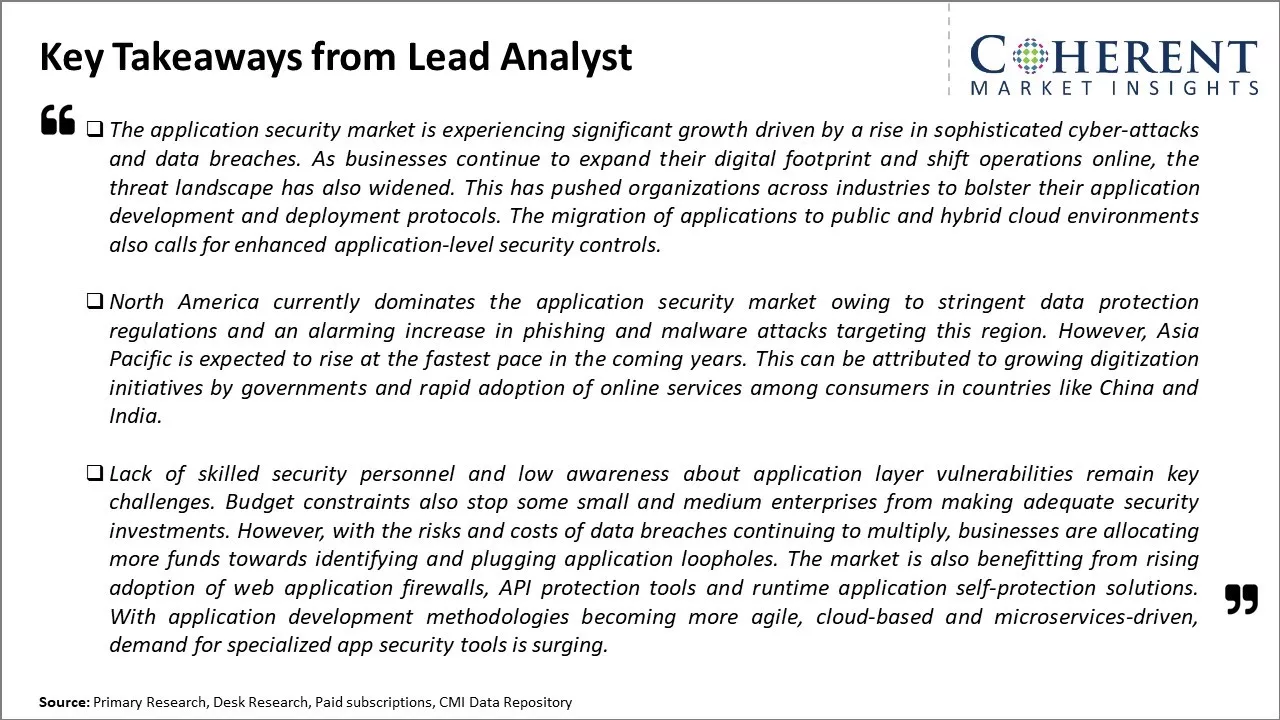
To learn more about this report, Download Free Sample
Market Challenge: Complexity of Modern ApplicationsThe application security market faces many challenges. As applications become more complex with new technologies like APIs, cloud, mobile, and IoT, they present a wider attack surface that is difficult for security teams to monitor and protect. Applications are also developed faster to meet business needs, resulting in weaker security if not addressed properly. Lack of skilled security professionals adds to the challenge, as it becomes hard for organizations to integrate security into the entire development lifecycle. Widespread remote work during the pandemic has further exacerbated risks.
Market Opportunities: Rising Demand for Advanced Application Security Solutions
With so many applications and new technologies requiring protection, there is a growing demand for advanced application security solutions. More companies recognize security as critical to their business and are willing to invest appropriately. Emerging approaches like shift-left and integrating security into DevOps promise to align security with speed of development.
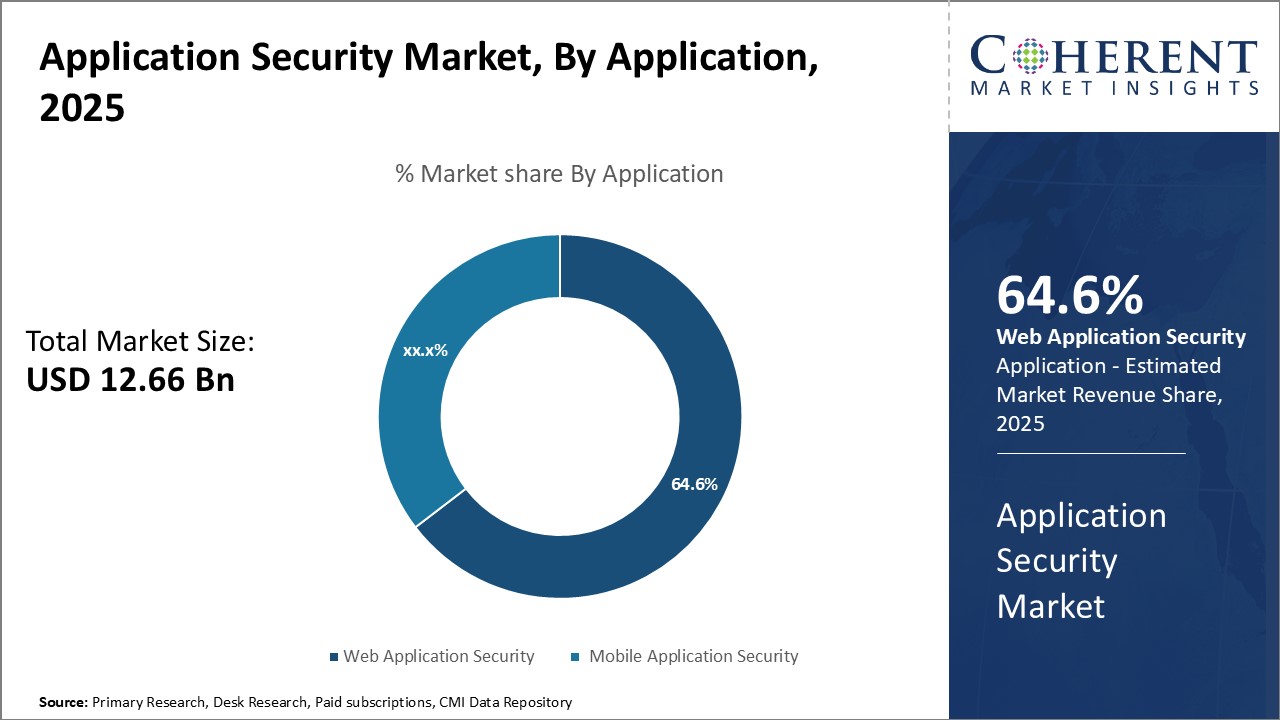
Discover high revenue pocket segments and roadmap to it: Download Free Sample
Insights, By Application- The Growing Reliance on Web Applications Drives Growth in Web Application SecurityThe web applications is estimated to hold the highest share of 64.6% in 2025, because web applications have become increasingly integral to business operations in recent years. As organizations expand their digital footprint and offer more services online, they have come to rely heavily on web applications to engage customers, drive revenue, and manage internal processes. However, this growing reliance on web applications has also increased associated security risks. Web applications are attractive targets for cyber attackers since they often interact directly with end users and hold large volumes of sensitive data. Hackers have exploited vulnerabilities in web applications to steal customer information, infiltrate internal systems, and inflict reputational damage on breached organizations.
Mobile application security is a critical facet within the broader domain of application security, playing a pivotal role in safeguarding mobile applications from potential threats and vulnerabilities. As the mobile landscape continues to expand rapidly, the Application Security Market has witnessed a surge in demand for robust security measures tailored specifically for mobile applications. This specialized branch of security encompasses various practices, such as secure coding, encryption, authentication mechanisms, and regular security assessments, aimed at fortifying mobile apps against unauthorized access, data breaches, and other malicious activities. With the increasing reliance on mobile applications across industries, ensuring the security of these applications has become a paramount concern, driving the growth and innovation in the Application Security Market to address the unique challenges posed by the mobile ecosystem.
Recognizing the risks, many businesses have increased investments in web application security solutions to better protect their online assets and customers. Web application vulnerability scanning tools that identify flaws before they are exploited have seen heightened demand. Enterprises also deploy web application firewalls (WAFs) at the perimeter to filter malicious traffic and block common exploits. As web applications become more complex with integrated features like APIs, single sign-on, and open source components, application security testing (AST) solutions that automate testing at multiple stages of the development lifecycle have grown in popularity. Furthermore, the shift towards cloud-based web apps has elevated the need for cloud-specific web application protection products.
Insights, By Deployment- The Cloud's Expanding Adoption Drives the Migration of Application Security to the Cloud
The cloud component is expected to hold the highest share of 69.48% in 2025, as cloud computing has transformed industries by offering scalable, on-demand IT resources and applications delivered as subscription-based services. Its economic and technical advantages over on-premises infrastructure have accelerated the migration of workloads to public cloud platforms like Amazon Web Services, Microsoft Azure, and Google Cloud.
As more applications move to the cloud, the task of securing these distributed platforms becomes inherently more complex. Legacy on-premises security tools lack the ability to continuously monitor and protect apps distributed across cloud environments. At the same time, cloud providers like AWS recognize security as a chief barrier limiting cloud adoption and have invested heavily in native security services. This has spurred rapid innovation and new categories of cloud-specific security solutions addressing virtual networks, containers, serverless infrastructure, cloud access, and more.
In the context of the application security Market, "on-premises" refers to a deployment model where security solutions and measures are implemented and managed within the organization's own physical infrastructure rather than relying on external cloud services. On-premises application security involves the installation and maintenance of security tools and protocols directly on the organization's servers and network infrastructure. This approach provides businesses with greater control over their security measures, allowing them to customize and tailor solutions to specific needs and compliance requirements. On-premises application security solutions often include firewalls, intrusion detection and prevention systems, encryption, and other protective measures designed to safeguard sensitive data and applications. While cloud-based security solutions have gained popularity, on-premises options remain relevant for enterprises seeking a higher degree of autonomy and control over their security infrastructure.
Driven by the momentum of public cloud adoption across enterprises, application security solutions optimized for cloud infrastructure have captured the largest share of the overall market. Cloud-native offerings address the unique requirements of securing elastic and distributed cloud environments more effectively than on-premises point solutions. As businesses increase their cloud footprints, demand for cloud-based application protection will continue growing at an accelerated pace.
Insights, By Type of Security Testing- Static Application Security Testing Drives the Segment with the Largest Share Holder
When it comes to application security testing methods, static application security testing (SAST) is expected to hold the largest share of 43.67% in 2025. SAST involves analyzing application source code without executing the software for vulnerabilities, flaws, and weaknesses. Its popularity stems from several key benefits over alternative dynamic and interactive testing approaches.
SAST is highly accurate at identifying a wide range of issues since analysis is performed directly on code. This static examination allows testers to examine all application paths and spots conditions that may not be triggered during normal usage or dynamic scans. SAST tools can also test early in the development process when dynamic analysis is not possible yet due to lack of execution environment availability. SAST yields very low false positive rates and requires less manual effort to validate findings. By pinpointing issues precisely in code locations, SAST results are more actionable for developers who can address security bugs without effort sorting through redundant alerts. This efficiency improves developer productivity and speeds remediation.
Finally, established SAST vendors offer broad language support that covers the major development technologies used by enterprises. Their analytics capabilities have also advanced to detect even complex vulnerabilities that elude basic scans. All these benefits have established SAST as a foundational element in the security programs of proactive organizations aiming for a shift-left approach. Its appeal and widespread adoption continue driving its leading market share over alternative application security testing types.
The application security market encompasses a range of tools and methodologies crucial for safeguarding software applications against cyber threats. Static Application Security Testing (SAST) involves analyzing the application's source code or binary code to identify vulnerabilities during the development phase. Dynamic Application Security Testing (DAST) evaluates the running application to discover vulnerabilities from an external perspective, simulating real-world attack scenarios. Interactive Application Security Testing (IAST) combines elements of both SAST and DAST, providing real-time analysis during application runtime. Run-Time Application Self Protection (RASP) is a security layer embedded within the application, dynamically identifying and mitigating threats during execution. These methodologies collectively contribute to a comprehensive defense strategy, addressing vulnerabilities at various stages of the application lifecycle and fortifying against evolving cyber threats in the dynamic landscape of the application security market.
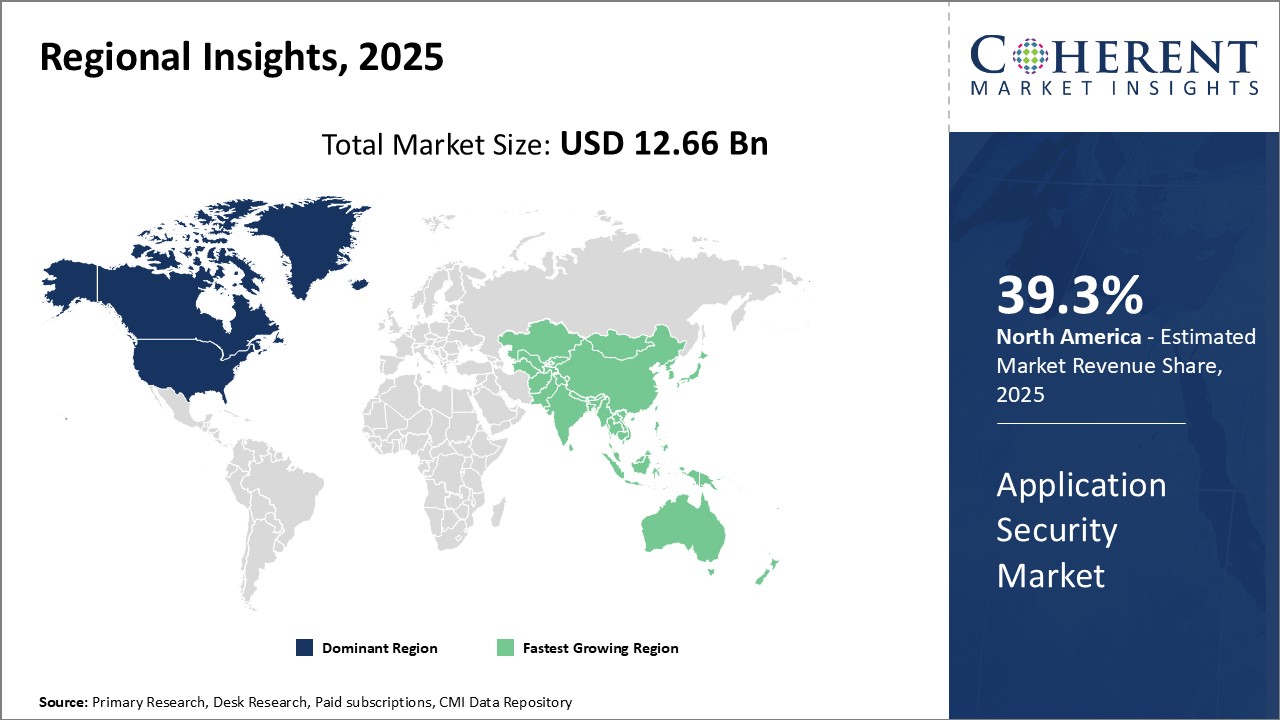
Need a Different Region or Segment? Download Free Sample
North America has emerged as the dominant region in the global application security market and is expected to hold the major share of 39.3% in 2025. With major industry players and tech giants located in the U.S. and Canada, the region has a strong industry presence and expertise in application development. Many organizations in North America are early adopters of new technologies and implement security best practices to secure their applications. Furthermore, investments in research and development of new application security solutions are high in the region.
The financial services, healthcare, and government sectors which involve handling of sensitive data are significant markets for application security vendors. The number of skilled security professionals is also higher compared to other regions, allowing for complex deployments. Export of security solutions from North America is contributing to its large market share. Overall high focus on data privacy and digital transformations is driving the growth of application security space.
The Asia Pacific region is witnessing the fastest growth in the application security market globally and is expected to hold a CAGR of 23.21% in 2025. Rapid digitalization of enterprises across industries like banking, e-commerce and manufacturing is propelling the need for application protection. Countries like China, India, Japan, and South Korea are generating huge online traffic and transactions. This exposes them to increased cyber threats if appropriate prevention measures are not taken. At the same time, these developing nations are investing heavily in IT infrastructures. This early stage of adoption provides huge market opportunity for application security vendors to implement best practices right from the start.
The region also has a large talent pool of developers and IT professionals. With growing global delivery models, application development activities are shifting to Asia Pacific. Securing such outsourced and offshored development processes has become an important requirement. Localization of solutions by global players and the emergence of local cybersecurity champions are also fuelling the Asia Pacific application security market growth. Rising exports in terms of IT services have made application security an integral part of their offerings.
Application Security Market Report Coverage
| Report Coverage | Details | ||
|---|---|---|---|
| Base Year: | 2024 | Market Size in 2025: | USD 12.66 Bn |
| Historical Data for: | 2020 To 2024 | Forecast Period: | 2025 To 2032 |
| Forecast Period 2025 to 2032 CAGR: | 18.6% | 2032 Value Projection: | USD 41.80 Bn |
| Geographies covered: |
|
||
| Segments covered: |
|
||
| Companies covered: |
Acunetix , CAST Software, Checkmarx Ltd. , Cisco Systems, Inc., Contrast Security , F5, Inc., Fasoo, GitLab, HCL Technologies Ltd, Hewlett Packard Enterprise Development LP , High-Tech Bridge SA , IBM Corporation, Micro Focus , Onapsis, Oracle , Positive Technologies , Pradeo , Qualys, Rapid7, SiteLock , Synopsys, Inc., Trustwave Holdings, Veracode, VMware, and WhiteHat Security |
||
| Growth Drivers: |
|
||
| Restraints & Challenges: |
|
||
Uncover macros and micros vetted on 75+ parameters: Get instant access to report
*Definition: The application security market involves solutions that help identify vulnerabilities, access risks, and ensure protection of applications from cyber threats. This growing market provides tools for preventing threats like injection attacks, unauthorized access, data breaches, and protects applications at all stages of development from design to deployment. Application security solutions enable organizations to integrate security practices into DevOps workflows and Software Development Life Cycle processes to develop secure software resistant to today's complex cyberattacks.
Share
Share
About Author
Ankur Rai is a Research Consultant with over 5 years of experience in handling consulting and syndicated reports across diverse sectors. He manages consulting and market research projects centered on go-to-market strategy, opportunity analysis, competitive landscape, and market size estimation and forecasting. He also advises clients on identifying and targeting absolute opportunities to penetrate untapped markets.
Missing comfort of reading report in your local language? Find your preferred language :
Transform your Strategy with Exclusive Trending Reports :
Frequently Asked Questions
Joining thousands of companies around the world committed to making the Excellent Business Solutions.
View All Our Clients